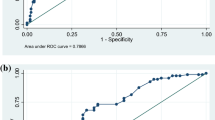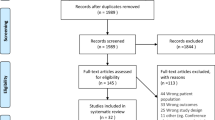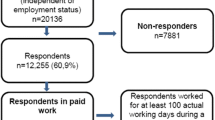Abstract
Objectives
This study aimed to explore and compare the ability of five instruments for self-rating to predict future sick leave rates.
Methods
In three Swedish municipalities 2,252 employees completed a baseline questionnaire and were followed up for 4 years. Five health-oriented instruments for self-rating were used as potential predictors of the two outcome measures no sick leave at all, and one or more spells of long-term sick leave ≥28 days. Positive and negative predictive values as well as Cox proportional hazard ratios (denoted as RRs) adjusted for age and work type were calculated.
Results
The instruments showed no statistical difference in predicting future sick leave for either of the sexes. For no sick leave RRs ranged between 1.27 and 1.52 (women), 1.35 and 1.61 (men); for long-term sick leave RRs ranged between 1.78 and 2.39 (women), 2.87 and 5.53 (men). However, the best prediction of long-term sick leave for men, RR 5.53, 95% confidence interval (CI) 3.37–9.08, was significantly higher than the best prediction for women, RR 2.39, 95% CI 1.97–2.90.
Conclusion
Prediction of long-term sick leave was better than that of no sick leave, and better among men than among women. There was a tendency for somewhat better prediction of future sick leave by multiple-question instruments, but single-question instruments can very well be used in predicting future sick leaves, and crude analyses stratified by sex can be used for screening purposes.
Similar content being viewed by others
References
Af Sillén U, Nilsson J-Å, Månsson N-O, Nilsson P (2005) Self-rated health in relation to age and gender: influence on mortality risk in the Malmö Preventive Project. Scand J Public Health 33:183–189
Altman DG, Bland JM (1994) Statistics notes: diagnostic tests 2: predictive values. BMJ 309:102
Bardage C, Isacsson D, Pedersen N (2001) Self-rated health as a predictor of mortality among persons with cardiovascular disease in Sweden. Scand J Public Health 29:13–22
Benyamini Y, Idler E (1999) Community studies reporting association between self-rated health and mortality. Res Aging 21:392–401
Benyamini Y, Leventhal EA, Leventhal H (2000) Gender differences in processing information for making self-assessments of health. Psychosom Med 62:354–364
Bjorner J, Kristensen T, Orth-Gomér K, Tibblin G, Sullivan M, Westerholm P (1996) Self-rated health—a useful concept in research, prevention and clinical medicine. In: Forskningsrådsnämnden (Swedish Council for Planning and Coordination of Research), Stockholm, p 144
Bowling A (2005) Just one question: if one question works, why ask several? J Epidemiol Community Health 59:342–345
Burstrom B, Fredlund P (2001) Self rated health: Is it as good a predictor of subsequent mortality among adults in lower as well as in higher social classes? J Epidemiol Community Health 55:836–840
DeSalvo KB, Fan VS, McDonell MB, Fihn SD (2005) Predicting mortality and healthcare utilization with a single question. Health Serv Res 40:1234–1246
Eriksson I, Undén A-L, Elofsson S (2001) Comparisons between three different measures. Results from a population study. Self-rated health. Int J Epidemiol 30:326–333
Heidrich J, Liese AD, Lowel H, Keil U (2002) Self-rated health and its relation to all-cause and cardiovascular mortality in Southern Germany. Results from the MONICA Augsburg Cohort Study 1984–1995. Ann Epidemiol 12:338–345
Huibers MJH et al (2004a) Predictors of outcome in fatigued employees on sick leave: results from a randomised trial. J Psychosom Res 57:443–449
Huibers MJH, Kant IJ, Knottnerus JA, Bleijenberg G, Swaen GMH, Kasl SV (2004b) Development of the chronic fatigue syndrome in severely fatigued employees: predictors of outcome in the Maastricht cohort study. J Epidemiol Community Health 58:877–882
Idler E, Benyamini Y (1997) Self-rated health and mortality: a review of twenty-seven community studies. J Health Soc Behav 38:21–37
Ilmarinen J, Tuomi K, Eskelinen L, Nygård C, Huuhtanen P, Klockars M (1991) Summary and recommendations of a project involving cross-sectional and follow-up studies on the aging worker in Finnish municipal occupations (1981–1985). Scand J Work Environ Health 17:135–141
Kaplan G et al (1996) Perceived health status and mobidity and mortality: evidence from Kuopio Ischaemic Heart Disease Risk Factor Study. Int J Epidemiol 25:259–265
Kemm JR (1993) Towards an epidemiology of positive health. Health Promot Int 8:129–134
Kujala V, Tammelin T, Remes J, Elina V, Ek E, Laitinen J (2006) Work ability index of young employees and their sickness absence during the following year. Scand J Work Environ Health 32:75–84
Larsson D, Hemmingsson T, Allebeck P, Lundberg I (2002) Self-rated health and mortality among young men: what is the relation and how may it be explained. Scand J Public Health 30:259–266
Lindberg P (2006) The work ability continuum. Epidemiological studies of factors promoting sustainable work ability. Doctoral thesis, Department of Clinical Neuroscience, Section of Personal Injury Prevention. Karolinska Institutet, Stockholm
Lund T, Borg V (1999) Work environment and self-rated health as predictors of remaining in work 5 years later among Danish employees 35–59 ears of age. Exp Aging Res 25:429–434
Mackenbach JP, Van den Bos J, Joung IMA, van de Mheen H, Stronks K (1994) The determinants of excellent health: different from the determinants of ill-health? Int J Epidemiol 23:1273–1281
Manderbacka K, Lahelma E, Martikainen P (1998) Examining the continuity of self-rated health. Int J Epidemiol 27:208–213
Moller L, Kristensen TS, Hollnagel H (1996) Self rated health as a predictor of coronary heart disease in Copenhagen, Denmark. J Epidemiol Community Health 50:423–428
Nordenfelt L (1987) On the nature of health. An action-theoretic approach. Kluwer Academic Publishers, Dordrecht
Reiso H, Nygård JF, Brage S, Gulbrandsen P, Tellnes G (2001) Work ability and duration of certified sickness absence. Scand J Public Health 29:218–225
Segovia J, Bartlett RF, Edwards AC (1989) An empirical analysis of the dimensions of health status measures. Soc Sci Med 29:761–768
Shadbolt B, Barresi J, Craft P (2002) Self-rated health as a predictor of survival among patients with advanced cancer. J Clin Oncol 20:2514–2519
Sullivan M, Karlsson J, Ware J, John E (1995) The Swedish SF-36 Health Survey-I. Evaluation of data quality, scaling assumptions, reliability and construct validity across general populations in Sweden. Soc Sci Med 41:1349–1358
Sullivan M, Karlsson J, Taft C (2002) SF-36 Hälsoenkät: Svensk Manual och Tolkningsguide (SF-36 Health Survey: Swedish Manual and Interpretation), 2nd edn. Sahlgrenska University Hospital, Gothenburg
Tuomi K, Ilmarinen J, Eskelinen L, Järvinen E, Toikkanen J, Klockars M (1991) Prevalence and incidence rates of diseases and work ability in different work categories of municipal occupations. Scand J Work Environ Health 17:67–74
Tuomi K et al (1997) Summary of Finnish research project (1981–1992) to promote the health and work ability of aging workers. Scand J Environ Health 23:66–71
Tuomi K, Ilmarinen J, Jahkola A, Katajarinne L, Tulkki A (1998) Work ability index, 2nd edn. Finnish Institute of Occupational Health, Helsinki
Vingård E et al (2005) Long-term sick-listing among women in the public sector and its associations with age, family, lifestyle and work. A three year follow up study. Scand J Public Health 33:370–375
Vuorisalmi M, Lintonen T, Jylha M (2005) Global self-rated health data from a longitudinal study predicted mortality better than comparative self-rated health in old age. J Clin Epidemiol 58:680–687
Ware JE, Sherbourne CD (1992) The MOS 36-item short form health survey (SF–36). I. Conceptual framework and item selection. Med Care 30:473–481
Ware JE, Snow K, Kosinski M, Gandek B (1993) SF–36 Health Survey Manual and Interpretation Guide. New England Medical Center, The Health Institute, Boston
Acknowledgments
The authors would like to thank statistician Stefan Stark of Uppsala University for preparing the data sets for the analyses. The HAKuL study was funded by a grant from AFA-Labour Market Insurance. There are no conflicts of interest.
Author information
Authors and Affiliations
Corresponding author
Rights and permissions
About this article
Cite this article
Lindberg, P., Josephson, M., Alfredsson, L. et al. Comparisons between five self-administered instruments predicting sick leaves in a 4-year follow-up. Int Arch Occup Environ Health 82, 227–234 (2009). https://doi.org/10.1007/s00420-008-0326-0
Received:
Accepted:
Published:
Issue Date:
DOI: https://doi.org/10.1007/s00420-008-0326-0




